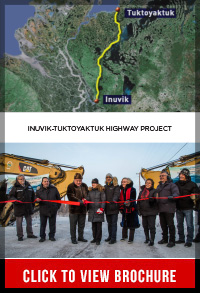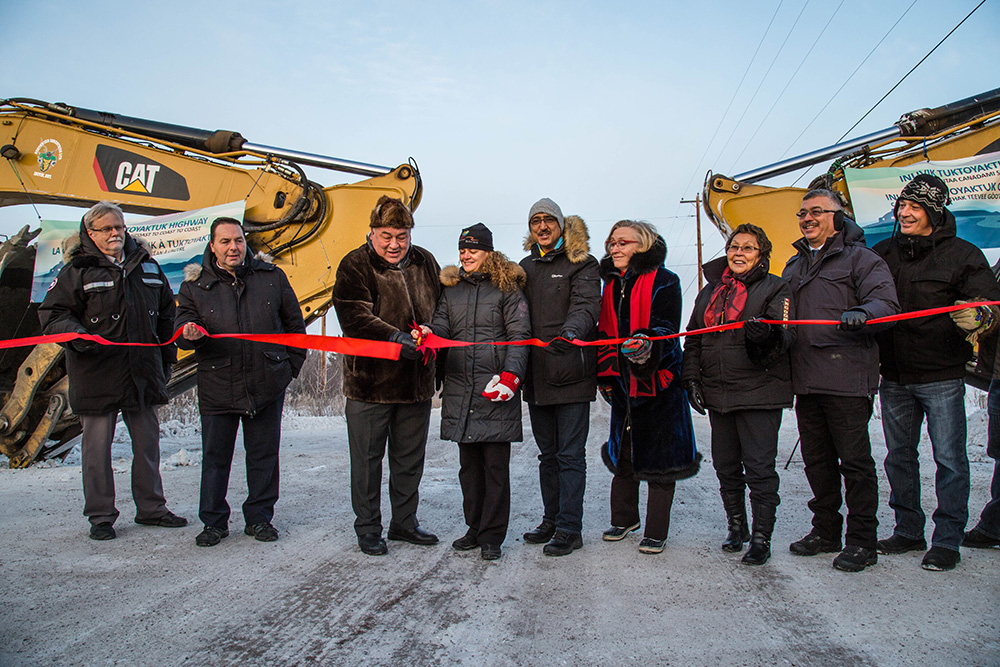The Road To The Top Of The World
By Anna Guy
 At noon on November 15, 2017, 132 years and 8 days after the Last Spike was driven into the Canadian Pacific Railway, the opening of the Inuvik-Tuktoyaktuk Highway, adding to the “nebulous dream” of connecting Canada sea to sea…to sea.
At noon on November 15, 2017, 132 years and 8 days after the Last Spike was driven into the Canadian Pacific Railway, the opening of the Inuvik-Tuktoyaktuk Highway, adding to the “nebulous dream” of connecting Canada sea to sea…to sea.
The Inuvik-Tuktoyaktuk highway connects us, the rest of Canada, to the Beaufort Sea, and the people of Tuktoyaktuk. The $300-million project took four years, and a great amount of community involvement, to complete. Governor General Julie Payette, on hand for the opening, said, “This is not just the construction of a road—it has meaning,” she told the crowd. The highway will have a “permanent impact” on life in the north, and is already precipitating increased tourism, and resource development simply by its existence. Tourism is projected to increase by $2.7 million annually, creating 22 full-time equivalent jobs in the NWT, and strengthening and expanding Inuvik’s role as regional commercial and business hub.
Nation Building
The road is “nation building” says Kevin McLeod, project manager and N.W.T.’s director of highways. “The highway represents three important pillars in terms of Canada and its place in on the world stage,” says McLeod. “First and foremost, are following a human trait of connecting communities,” says McLeod, noting the year-round, all-weather road to connect an outlying community to the rest of Canada, replacing the ice road that was only used in the winter.
“Secondly, the road allows access to more resources that could be viably extracted in the future. And third, is our Arctic sovereignty,” says McLeod. “Tuktoyaktuk is at the mouth of the North West Passage, and has always been quite important to Canada and building a land-based access to it in eyes to the other Arctic nations is a sovereignty issue.”
Community Involvement
The unifying effect of the highway isn’t solely symbolic, says McLeod. Construction involved cooperation from many community members, specifically the people of Inuvik and Tuktoyaktuk, both in the construction and consultation.
“There was a significant training component attached to the project,” says McLeod. “Our aim was to introduce folks to employment on the project, including driving, working on new equipment, welding, parks management, cooking in the camps. This is more than just a highway. Through training, we hope to impart life changing skills workers could take on to their next project.”
The main training effort has been on the heavy equipment operators resulting in more than 70 individuals receiving training on rock truck and excavator equipment using a simulator. The project has delivered training to approximately 130 individuals as Class 1 and 3 drivers, equipment operators, summer students, and apprentices.
Additionally, the highway will mean years of employment, long-term and permanent jobs. Residents of Tuktoyaktuk will benefit from a reduced cost of living (approximately $1.5 million in savings), as goods will be able to be shipped year-round. Opportunities for family, social, recreational and sporting interactions will increase, and residents will have improved access to health care, educational and economic opportunities.
New Era
The $300-million road will cross a rolling landscape of tundra and lakes with many stream crossings and bridges. “It’s in terrain that’s not mirrored anywhere else in the world. It’s challenging and it’s difficult,” says McLeod, adding “It meanders throughout the tundra and tree line and above the tree line onto the arctic plateau. Travellers will experience three distinct topography and geophysical areas.”
The Inuvik-Tuktoyaktuk Highway is the beginning of a new era for Canada’s North, says McLeod. “It’s a project we are very proud of, because it means more opportunities for our Northern communities.”






